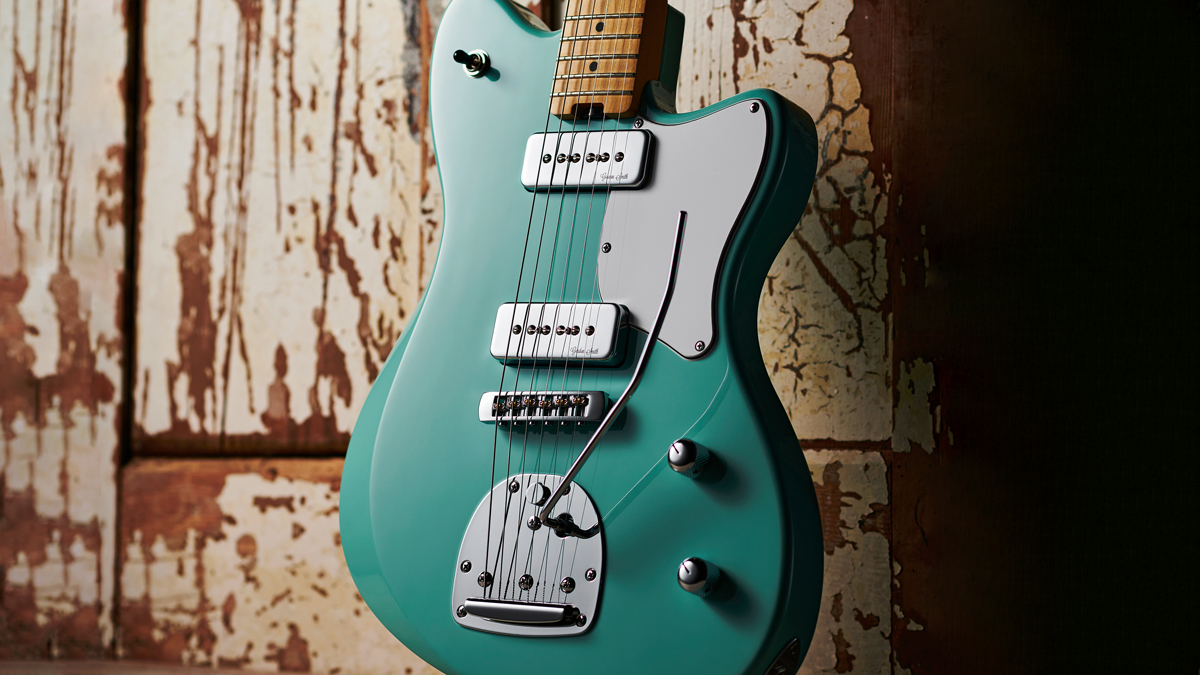Guitar World Verdict
There’s an awful lot to like here. The Gatsby is a stylish, slightly downsized offset at a great price for a UK-made guitar, and there are plenty of customer-order options, not to mention colours available.
Pros
- +
Tidy build matched by a very attractive price.
- +
Versatile duality from the pickups.
- +
An excellent in-tune vibrato system.
Cons
- -
A little fingerboard edge rolling would help, not least with the 305mm fingerboard radius.
You can trust Guitar World
As long-time fans of Gordon Smith guitars in both their original incarnation and their relatively new guise under new owners, the Auden Musical Instrument Company, it’s been a little while since we’ve featured one in our pages. Why? Because, as MD Doug Sparkes is forever telling us, “They’re all sold!” But earlier this year the company’s latest design, the Gatsby, surfaced and finally we got one in its Launch Edition splendour.
The Gatsby was designed to “broaden the appeal of Gordon Smith, certainly for younger players,” Doug tells us. “It isn’t exactly fashion-led, but we feel it’s a little more in the moment. It also provides us with the opportunity to get into a different part of the market. Gordon Smith has never made an offset before so we thought we’d put something out there and see what sort of response we got. And judging by the Launch Edition models – like the one you have – the response has been fantastic.”
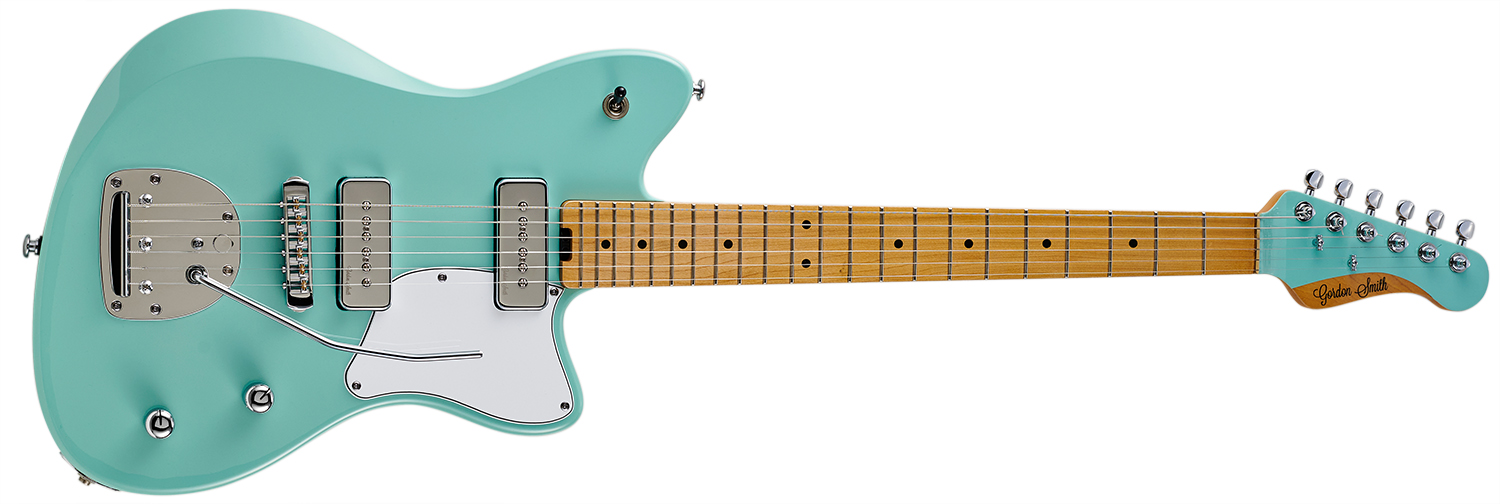
The general term for anything remotely inspired by the Fender Jazzmaster or Jaguar is, of course, ‘offset’, referring to the waist of the guitar that’s higher on the bass side than it is on the treble.
But, as we saw in our last issue with PJD’s St John (another Brit-made offset guitar), redesigning that classic outline is very much of the moment. As any Jazzmaster player knows, they are big guitars – the larger, longer body can add weight, too – so downsizing has its appeal, especially when it’s done as elegantly as this.
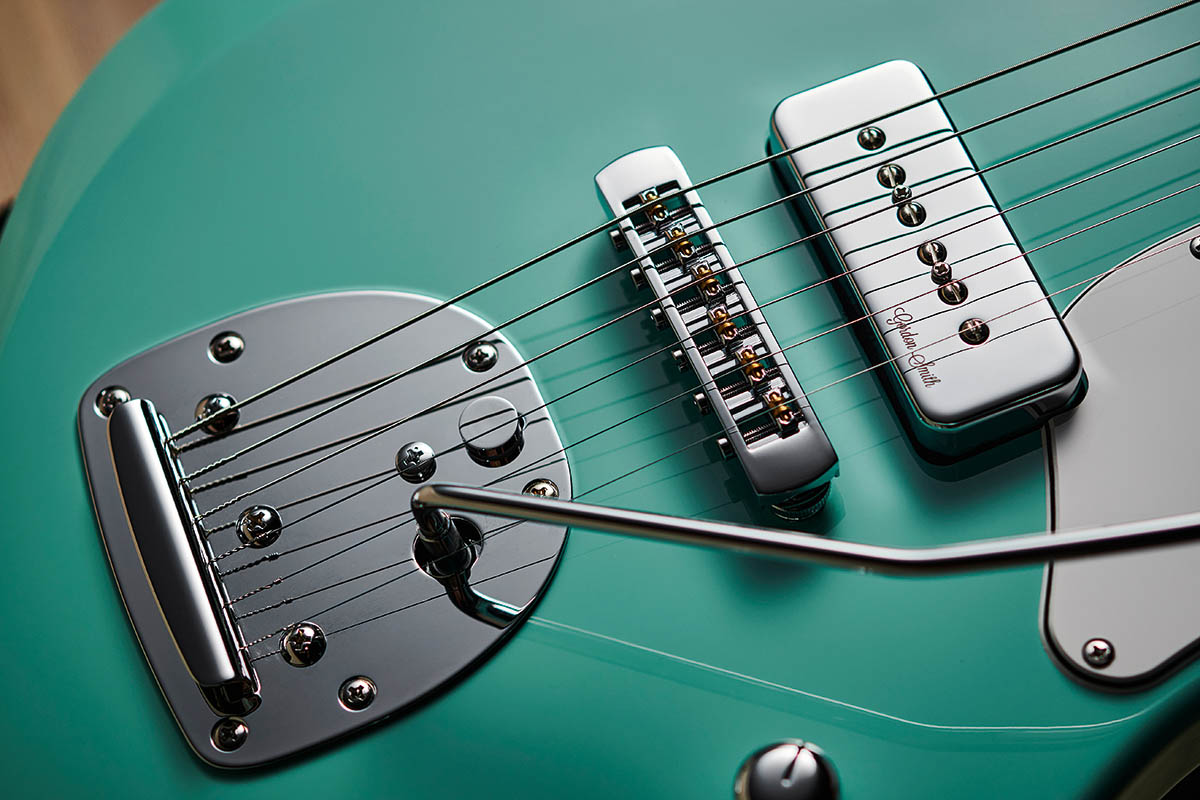
“We’re constantly being asked for lightweight guitars; it’s a real thing at the moment,” continues Doug. “The idea that your guitar had to break your shoulder after 45 minutes, well, people seem to have moved on from that,” he laughs. “So we just put that into the design brief of the Gatsby. We have this incredible young designer, Elliot Heggie, who joined us probably 18 months ago, and has been working on a whole new range of guitars for us. This is the first product of his that he’s designed from a blank sheet of paper.”
The Launch Edition specification is for a poplar body (ash is used on the see-through Tobacco), with a bolt-on maple neck, a maple fingerboard and a range of seven colours. Beyond this standard specification you can custom-order a Gatsby from the drop-down menu on Gordon Smith’s website. “We have a lead time of about 12 weeks,” says Doug, though he warns that “like everyone, we are struggling to get materials and components”.

Like that PJD St John, the Gatsby’s 45mm thick body is downsized in comparison to its inspiration, with a mainly slab body that has a stylish forearm chamfer and light rib-cage cutaway. The heel area is relieved, too, and the design allows great access to the top of the fingerboard where you’ll also see a handy wheel adjuster for the truss rod.
The headstock doesn’t mess too much with the classic bolt-on style, either, and the finish is relieved on the treble side to provide a contrast with the natural wood and a place for the logo. There’s something very familiar about the overall design, which is very easy on the eye.
“We certainly didn’t want it to be radical,” says Doug. “We’re not trying to reinvent the wheel. We just wanted to have our flavour in it, and I think Elliot achieved that really well.”
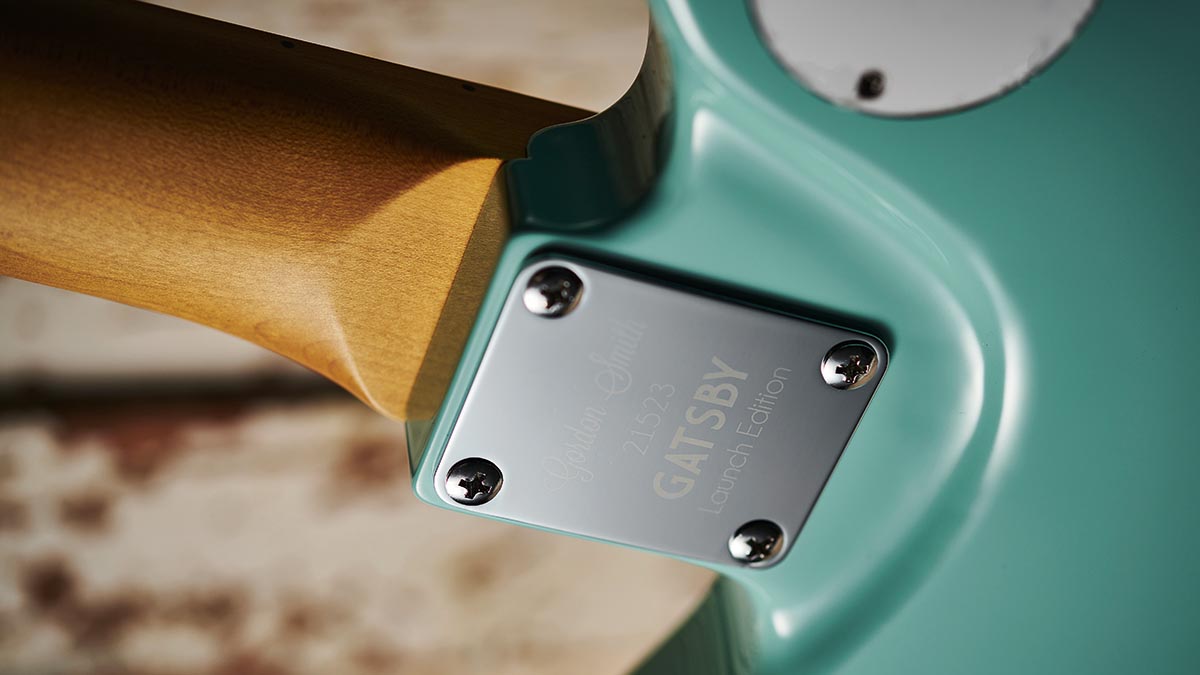
The generic Jazzmaster/Jaguar vibrato here is very much a part of the offset style and it’s married to a rather neat roller bridge that is firmly mounted and doesn’t rock. Any movement of the strings over the saddles is friction-free thanks to those free-moving rollers.
There’s some ballsy grind that recalls a Gibson Junior here, and the vibrato takes us via Neil Young into some dirty grunge
The ‘dead’ string length behind the bridge is considerable in this style, and the height of the bridge affects how much of that impacts what we hear: too low and you really hear some quite honky resonances; too high, well, you lose that dead string resonance.
Here, with the bridge around 17mm (from the G string to the top of the body), we have more of the firmness of the latter setup, which is ideal for general use but it’s maybe slightly too high if you enjoy the funkier and more unpredictable response of a shallower string angle with a lower bridge. The Huber Piet prototype we evaluated last year, for example, had a lower bridge height (around 14mm) and noticeably more ‘dead string’ resonance.
Feel & Sounds
With a good light weight of 3.57kg (7.85lb), the Gatsby feels great when played seated or strapped on. The neck is a fairly conventional full ‘C’ that has a depth of 20.8mm at the 1st fret and 22.9mm by the 12th – slightly bigger in the upper reaches than those Fender Player Plus models we evaluated last issue.
In fact, the fretwire is pretty similar in size, too (approximately 2.62mm wide by 1.14mm high), very slightly higher than those Fenders, and the frets are very nicely fettled. The setup is excellent, and although a brass nut is rare these days it’s well shaped and polished and certainly doesn’t impair the excellent tuning stability. Plus, with a satin back and fingerboard face, it’s an easy player.
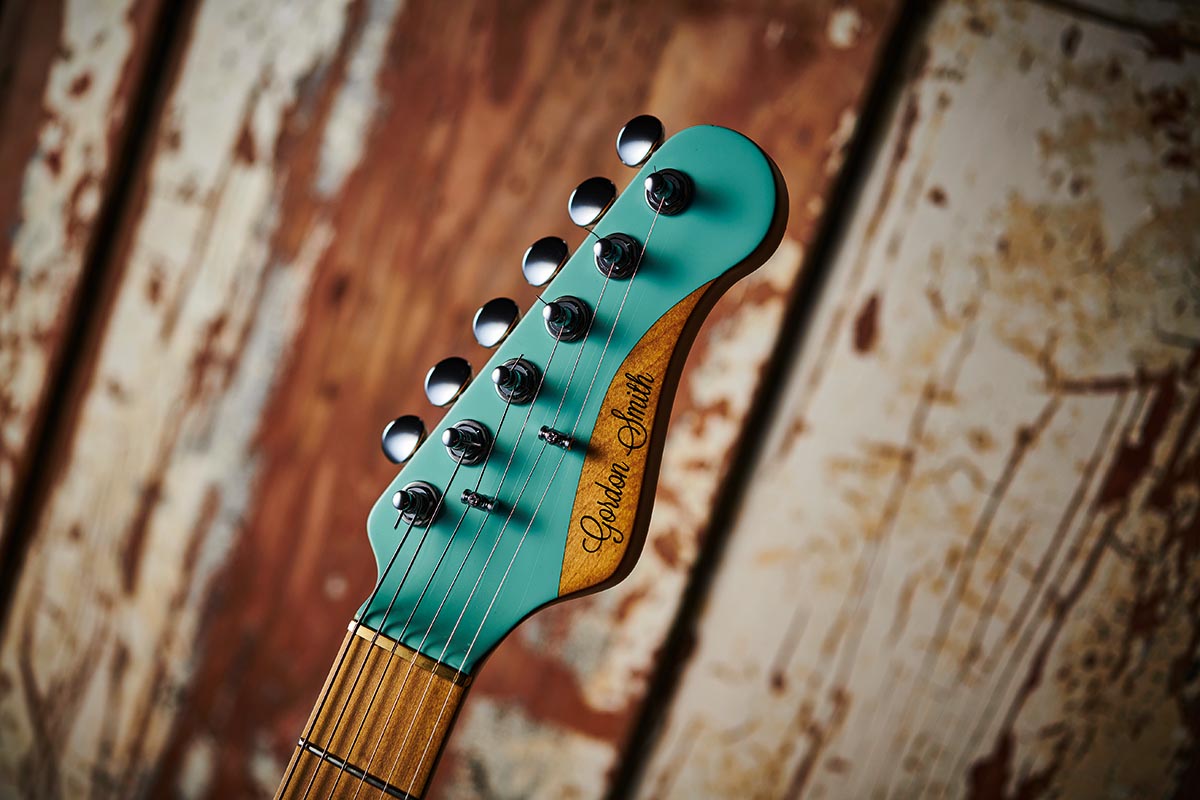
The Gatsby has an appealing and very Fender-y acoustic response, but plugged in things begin to change. For example, there’s quite a duality here that moves from frankly a pretty full Strat-like voice at the neck to the more Gibson-esque character at the bridge.
The neck has quite a smooth attack, less ‘smash’ than a good Strat but with a full and quite woody percussiveness. The mix retains a crispness and funk and on cleaner amp tones, too. These two selections cover a lot of ground.
Switch to the bridge and that rowdy rocking cousin shows up: rougher and rawer with a good volume lift and quite a nasty – as in good! – snarl. Again, the high-end is slightly rounded.

As we up the volume it’s a lively guitar and these pickups don’t sound potted (even though they are) and really pick up any taps and thumps from the body. There’s some ballsy grind that recalls a Gibson Junior here, and the vibrato takes us via Neil Young into some dirty grunge. And while a vibrato system like this is an awful lot cheaper than the highly regarded Mastery, its smooth, really quite Bigsby-like feel, in-tuneness and pitch stability are very good indeed.
The volume control is nicely graduated, but the tone does take a little while on its travel to pull the highs back. We can’t help thinking this has ‘pedalboard driver’ written all over it.
Complaints? Well, the vibrato arm has no tip and does feel a little rudimentary, and there’s no hum-cancelling in that middle mixed pickup position. Those fingerboard edges, with the 305mm (12-inch) fingerboard radius, do feel a little sharp – not least following the necks we got to experience with Fender’s new Player Plus models, which share the same radius.
Verdict
There’s an awful lot to like here. The Gatsby is a stylish, slightly downsized offset at a great price for a UK-made guitar, and there are plenty of customer-order options, not to mention colours available. The vibrato and bridge setup is excellent and works effortlessly – something that not all Jazzmaster/Jaguar owners can say.
Sounds-wise, it’s no slouch and there’s a good Fender/Gibson flavour here, too, between the neck and bridge pickups, again expanding the offset style and, as ever, there are plenty of aftermarket soapbars if you want to experiment post-purchase.
After all, a bit of modding is very much a part of the offset genre. A very credible addition to Gordon Smith’s ever-increasing catalogue. A great Gatsby? It’s a yes from us.
Specs
- PRICE: £1,299 (inc gigbag)
- ORIGIN: UK
- TYPE: Double-cutaway offset solidbody electric
- BODY: Poplar
- NECK: Maple, bolt-on
- SCALE LENGTH: 648mm (25.5”)
- NUT/WIDTH: Brass/42.3mm
- FINGERBOARD: Maple, black dot inlays, 305mm (12”) radius
- FRETS: 22, medium
- HARDWARE: Golden Age tune-o-matic-style roller bridge, Hosco HK41vibrato, Gotoh SG381 enclosed tuners – chrome-plated
- STRING SPACING, BRIDGE: 52mm
- ELECTRICS: 2x GS ‘Homewound’ soapbar single coils in chromed brass covers, 3-way toggle switch pickup selector, master volume and tone controls
- WEIGHT (kg/lb): 3.57/7.85
- OPTIONS: The base price is £1,299. For options see drop-down menu on website
- RANGE OPTIONS: The classic GS starts at £799, the start-point to a now 14-strong range – all of which can be custom-ordered
- LEFT-HANDERS: Yes, same price
- FINISHES: Cromer (as reviewed), Merlot, Vintage White, Real Ale, Rockingham, Tobacco, Jet Black
- CONTACT: Gordon Smith

Dave Burrluck is one of the world’s most experienced guitar journalists, who started writing back in the '80s for International Musician and Recording World, co-founded The Guitar Magazine and has been the Gear Reviews Editor of Guitarist magazine for the past two decades. Along the way, Dave has been the sole author of The PRS Guitar Book and The Player's Guide to Guitar Maintenance as well as contributing to numerous other books on the electric guitar. Dave is an active gigging and recording musician and still finds time to make, repair and mod guitars, not least for Guitarist’s The Mod Squad.
“It holds its own purely as a playable guitar. It’s really cool for the traveling musician – you can bring it on a flight and it fits beneath the seat”: Why Steve Stevens put his name to a foldable guitar
“Finely tuned instruments with effortless playability and one of the best vibratos there is”: PRS Standard 24 Satin and S2 Standard 24 Satin review
